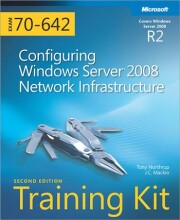Configuring Name Resolution - Understanding Name Resolution in Windows Server 2008 Networks
9 important questions on Configuring Name Resolution - Understanding Name Resolution in Windows Server 2008 Networks
When is LLMNR enabled?
In Windows Vista and Windows 2008, LLMNR is enabled only when Network Discovery is enabled. However in Windows 7 and Windows Server 2008 R2 LLMNR is enabled by default without Network Discovery. Unless it is specifically enabled in GroupPolicy. LLMNR is used as an active name resolution mechanism as long as IPv6 remains enabled. Finally, even when IPv6 is disabled both Windows 7 and Windows server 2008 R2 respond to LLMNR queries over IPv4.
What are forwarded and Reserve lookup zones?
Zones can occur in one or two varieties: Forward lookup zones and reserve lookup zones. A forward lookup zone is the main type of zone, in which names are resolved to IP addresses. In a reverse lookup zone, an IP address is resolved to a name.
If a computer needs to resolve a DNS name, what is the first method it attempts to use?
A computer first checks the resolver cache to answer a query.
- Higher grades + faster learning
- Never study anything twice
- 100% sure, 100% understanding
When a DNS server recieves a query, how does it first attempt to resolve the name?
A DNS server first attempts to resolve a query by using resource record stored in a locally configured zone.
If a DNS server cannot resolve a query, by using the first method, which method will it use next?
If a DNS server cannot resolve a query by using zone data, it attempts to answer the query by using cached information.
When would a DNS server contact a root server?
A DNS server contacts a root server when it cannot answer a query with its own cached or authoritative data.
If a DNS server contacts a root server to resolve the name www.contoso.com and the root server cannot answer the query, how does the original server know which server to query next?
The root server responds to the DNS server with a referral for the address of the DNS server authoritative for the .com domain. The DNS server then contacts this server for which it has received a referral.
How is the host file used?
Whenever you add an entry to the host file, that entry is immadiately loaded into the DNS resolver cache.
After the address of a remote computer is updated, you notice that a local DNS server is resolving the name of the computer incorrectly from cached information. How can you best solve this problem?
At the DNS server type in cmd: dnscmd /clearcache
The question on the page originate from the summary of the following study material:
- A unique study and practice tool
- Never study anything twice again
- Get the grades you hope for
- 100% sure, 100% understanding
































